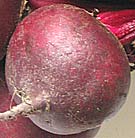Beetroot - an easy to grow root vegetable
BEETROOT VARIETIES TO GROW
GLOBE
Crimson Globe,
Little ball,
Bolthardy,
Detroit Red,
Avonearly
Golden (does not bleed when cooked),
Ruddigore,
Early Bunch,
Monogram,
Regala

INTERMEDIATE
Cylindra,
Foron
LONG ROOTED
Long Blood Red,
Cheltenham Green Top
It is now possible to buy monogerm beetroot seed producing only single seedlings.
This makes the tedious job of thinning beetroot that much easier.
SEASONAL TIPS
Early Spring
Sow beetroot in spring as soon as the soil can be worked. Young beetroot
seedlings can tolerate freezing temperatures
Summer
Plant small batches of of short season varieties every 2 - 3 weeks througn
midsummer. Begin harvesting when beetroots reach 3 - 4cm in diameter.
Autumn
Sow autumn crops 4 - 7 weeks before the first frosts. Harvest after a
frost.
SOCIETIES
BEETROOT
 Beetroot
are simple to grow and do not need much space.
Beetroot
are simple to grow and do not need much space.
This root and leaf vegetable comes in a wide variety of of colours and shapes.
These vegetables thrive in full sun, but summer or early autumn crops can tolerate partial shade.
They are easily stored - so a beetroot supply can be available all year round.
DIFFERENT TYPES OF BEETROOT
There are three main types of beetroot, Globe, Long –rooted (can be a foot long) and intermediate, sometimes called "tankard" because of the squat shape.
The globe beetroot is best sown in early spring and pulled in June ready for eating with summer salads.
The long-rooted and intermediate beetroot types are best sown in May and early June. These you can pull in the Autumn, and store for use in the winter through to April and May.
GENERAL ADVICE ON SOWING BEETROOT SEED
Avoid sowing beetroot on freshly manured ground.
You can apply a general fertilizer if the soil requires it, at a rate of 2 oz to the square yard.
GROWING BEETROOT FOR AN EARLY CROP
Globe beetroot should be sown in late February or the beginning of March.
Prepare a seed bed in a cold frame or cloche.
Make the drills shallow at half an inch, and six inches apart. Sow the beetroot seed thinly then cover the drills lightly with the back of the rake.
Before the beetroot seedlings become over crowded thin down to 5-6 inches apart.
Harden the seedlings off by gradually exposing them to colder temperatures over a few weeks, finally removing the the glass top from the cold frame or cloches by mid April.
Do not let the beetroot bed dry out, keep the beds moist.
SOWING THE MAIN BEETROOT CROP
From mid-May to early June you can sow the long-rooted or intermediate types in succession.
You could also sow globe beetroot in July for pulling in the Autumn and winter.lls for beetroot at 1 inch deep and 12 inches apart.
Thinly sow the beetroot seeds and cover with soil by raking over with the back of the rake.
After the first rough leaves appear, thin seedlings to about 2 inches apart, so as to leave only one plant each place.
Continue to thin, and during July remove every other beetroot plant for use while still young and fresh. This should leave the remaining beetroot about 4-5 inches apart.
PROTECTING SEEDLINGS
Protect the emerging beetroot seedlings with nylon netting as soon as they start to germinate as they are very attractive to the birds
WATERING AND HOEING
Beetroot do not need a lot of water but keep moist when seedlings.
Hoe on a regular basis between the plants to keep the weeds at bay, taking care that you do not damage the roots as they will bleed. This can cause loss of colour and flavour.
PULLING AND STORING BEETROOT
Pull the globe beetroot in June when they are about the size of a tennis ball. They can become hard and woody if allowed to grow any bigger.
They should be stored if not wanted immediately.
Pull the early successional beetroot sowings when large enough to eat. That should be from about early August onwards.
Beetroot maincrop roots for storage should be pulled in October.
When you start to pull the beetroot using a fork be careful you do not damage or bruise them.
Do not store damaged beetroot because they will only rot and ruin your stored crop.
Twist off the beetroot leaves not too close to the crown.
Store beetroot in a cool place in a box with some damp sand in the bottom and cover with more sand . Additional layers of sand and beetroot can be added as and when they have grown large enough to store.